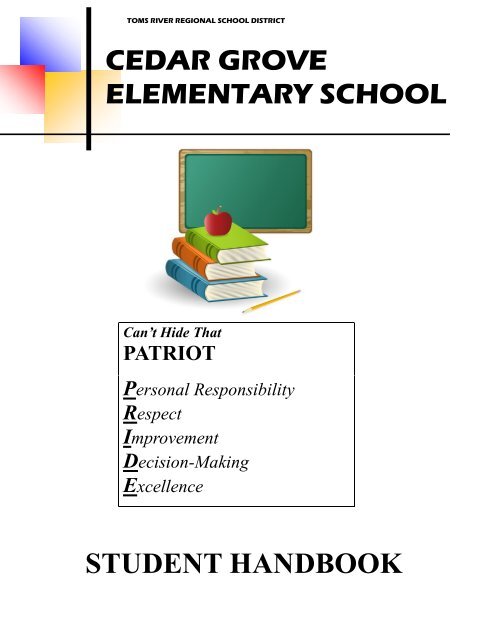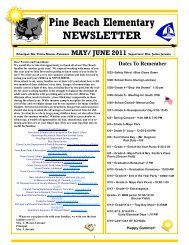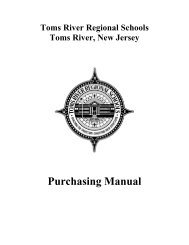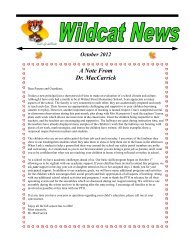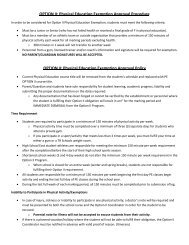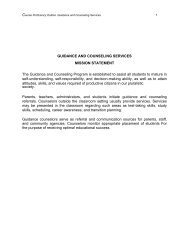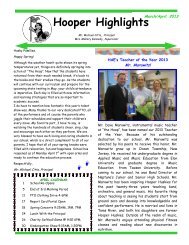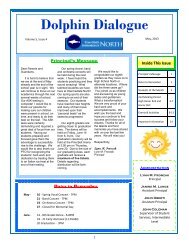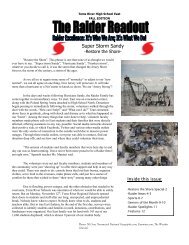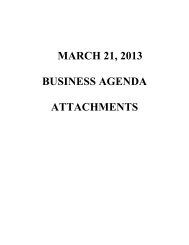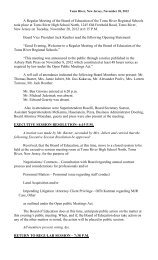Student Handbook - Toms River Regional Schools
Student Handbook - Toms River Regional Schools
Student Handbook - Toms River Regional Schools
Create successful ePaper yourself
Turn your PDF publications into a flip-book with our unique Google optimized e-Paper software.
TOMS RIVER REGIONAL SCHOOL DISTRICT<br />
CEDAR GROVE<br />
ELEMENTARY SCHOOL<br />
Can’t Hide That<br />
PATRIOT<br />
Personal Responsibility<br />
Respect<br />
Improvement<br />
Decision-Making<br />
Excellence<br />
STUDENT HANDBOOK
PREFACE FOR PARENTS/GUARDIANS<br />
Dear Parents/Guardians,<br />
The objective of this handbook is to give our children direction and guidance in fulfilling their daily<br />
responsibility at Cedar Grove School.<br />
We realize that all of the children cannot read and comprehend the handbook’s contents, so we are<br />
requesting that the parents/guardians explain its meaning to their children, especially those in the lower primary<br />
grades.<br />
As parents/guardians we all want the best for our children. We treat them with kindness and respect and<br />
provide them with the care they need to grow and mature effectively. Hopefully, they will practice the courtesy;<br />
manners and respect that we teach them at home in the school setting.<br />
We at Cedar Grove School become the children’s parents/guardians during the school day. Please help us to<br />
reinforce the concepts stated in this handbook. A full education is much more than academic subjects; we are<br />
concerned with the children’s physical, emotional, and social growth as well.<br />
Thank you for your cooperation. Together, we will continue to provide an excellent school year for our<br />
children.<br />
Sincerely,<br />
Jeffrey D. Ryan, Principal<br />
Stacey DeCesare-Monetti, Supervisor
PHILOSOPHY<br />
Dear Girls and Boys,<br />
Cedar Grove School was built for you and all the children who attend class each day. The school was not<br />
constructed for any of the people that work in the building. The teachers, custodians, cafeteria workers, aides, the<br />
supervisor, principal and secretaries would not be here if there were no children to attend school.<br />
The main purpose of your school is to provide you with the best possible education. While we are all<br />
working toward this goal, we want your learning experiences to be fun and enjoyable. We can help you learn, but<br />
this can only be accomplished with your effort, cooperation and the fulfillment of your responsibilities.<br />
Education is more than reading, writing, arithmetic, science, spelling, etc. A complete education includes<br />
learning how to work and play with people, being responsible for your actions, and respecting the rights and<br />
property of others.<br />
Always remember that at Cedar Grove School we are “Proud Patriots.”<br />
Jeffrey D. Ryan<br />
Principal<br />
Stacey DeCesare-Monetti<br />
Supervisor
Dear Parents/Guardians,<br />
The following information will provide you with a detailed description of our drop-off and pick-up traffic procedure.<br />
This procedure will enable us to more effectively control and maintain the safety of the children.<br />
We would like to thank all of you who have been a part of this process in the past and have complied to help make<br />
it a smooth and efficient one. Please review the written directions along with the accompanying map to familiarize<br />
yourself with the procedure.<br />
PROCEDURE<br />
The entrance, driveway and traffic circle in the front of the school will be used exclusively for our school busses.<br />
The area located at the southern side of the building, which can be accessed by way of Brookside Drive, will be used<br />
exclusively for parent drop-off and pick-up of students.<br />
Morning Drop-Off Procedure<br />
In the morning, cars dropping off students for Excel, Pride or any other before school activity will be permitted to<br />
use the front traffic circle until 8:45 A.M. However between the hours of 8:45 A.M. and 9:30 A.M. the Cedar<br />
Grove Road entrance to the school will be closed to all vehicular traffic. During this time school busses only<br />
will be permitted to enter at Cedar Grove Road and will use the front traffic circle for student drop-off.<br />
Between the 9:00 A.M. - 9:30 A.M. time period, parents who will be dropping their children off will be required to do<br />
so by way of the Brookside Drive entrance only. Cars are to enter the blacktop area keeping to their right and<br />
proceeding to the rear of the South Court. Staying to the right in a single lane, parents are to follow the curb line<br />
that borders the school building driving along that curb and stopping where designated for curbside drop-off of their<br />
child(ren). They are to immediately leave the South Court by proceeding to the Brookside Drive exit where they had<br />
entered. This is a two-way traffic driveway all drivers are reminded to stay to their right at all times.<br />
We ask for your patience, especially during inclement weather, as you wait in line to drop off your child/ren at the<br />
curb. Line cutting is potentially dangerous to our students and may cause motor vehicle accidents.<br />
Afternoon Pick-Up Procedure<br />
As is the case during the morning procedure, the Cedar Grove Road entrance to the building and the front traffic<br />
circle will be used exclusively for school busses at dismissal. Between the hours of 2:45 P.M. to 3:30 P.M. the<br />
Cedar Grove Road entrance to the school will be closed to all other vehicular traffic.<br />
During the afternoon those parents who will be picking up their children are required to enter the South Court lot by<br />
way of the Brookside Drive entrance. Cars will proceed into the lot and park in the designated ferry-like car lanes.<br />
Drivers should fill in one behind the other starting in the first lane closest to the school. This procedure may begin<br />
anytime after 3:00 P.M. and last until 3:15 P.M. At 3:15 P.M. no further traffic will be permitted into the<br />
South Court lot and all cars there are to be appropriately parked in the designated car lanes. <strong>Student</strong>s<br />
who are walkers and/or who will be picked up from school will be dismissed at 3:20 P.M. For reasons of safety, no<br />
vehicles will be allowed to depart from the South Court lot until all students have cleared the lot. This plan is similar<br />
to procedures used at several district elementary schools. A school employee will signal your departure. Cars will<br />
exit the same two-way driveway onto Brookside Drive. Cars are dismissed in the order they arrive, so again, your<br />
patience is appreciated.
<strong>Student</strong>s who ride busses will be dismissed to the front traffic circle at 3:20 P.M. and busses will be dismissed when<br />
all bus students have boarded their busses and the traffic circle is cleared of all students. The departure of the<br />
busses and of those parents from the South Court lot will be independent of one another. This procedure will ease<br />
the traffic congestion on Brookside Drive and Cedar Grove Road. It will also provide a higher degree of control and<br />
safety of the students who are walkers or who will be picked up each day.<br />
<strong>Student</strong>s who walk to or from school and are not driven by a parent or guardian will not be affected in any way by<br />
this procedure. Please be reminded that students who are not involved in before school activities are<br />
not to enter the building until 9:00 A.M. Your adherence to the parameters of this procedure is necessary for<br />
its success.<br />
The administrators and teachers will review the procedure once again with the students and we ask that you read,<br />
review and retain this letter and map for future reference. If you have any questions or the procedures for<br />
afternoon dismissal are not conducive to your schedule, please contact the main office for an alternate dismissal<br />
program.<br />
Respectfully,<br />
Jeffrey D. Ryan<br />
Principal
SCHOOL BUS<br />
The school bus is to take you to and from school safely. On the bus you should always sit facing front with<br />
your feet under the seat and your seatbelt on. We expect you to talk quietly to your friends, and not yell and/or<br />
scream. The bus drivers must pay attention to the traffic on the road. They must also listen for horns, sirens, and<br />
be alert for emergencies. Bus drivers cannot pay attention to the road and look at you at the same time. An<br />
accident can happen in a split second. If the bus driver must make a short stop you could prevent an injury by<br />
sitting properly.<br />
Everyone can help the driver operate a safe bus. Listen to the driver and think of safety first. Remember, if<br />
the bus is ever involved in an accident, you may be the one to suffer an injury.<br />
The law states that riding the school bus is a privilege and not a right. To insure the safety of our<br />
children, school buses are now equipped with cameras and microphones. You can lose your bus privilege at any<br />
time, if you are not conducting yourself in a proper and safe manner. The loss of your bus privilege means that<br />
your parents/guardians will have to drive you to and from school.<br />
The parent/guardian will be notified of any bus discipline slips received for their children. The procedure for<br />
suspension of bus privilege is as follows:<br />
1. First letter - warning<br />
2. Second letter – parent contact and/or conference<br />
3. Third letter – ten day suspension of bus privileges<br />
4. Fourth letter – bus privileges will be suspended for the remainder of the school year<br />
At the beginning and end of the school day we always expect you to walk on the sidewalk to and from the<br />
bus. Running in a crowd may cause an injury to you and others.<br />
Occasionally parents request that their child be allowed to ride home on a bus other than his/her assigned<br />
bus. Requests of this nature CANNOT be honored as it frequently causes an overload condition and can result in<br />
confusion for the children.<br />
No telephone calls will be accepted for requests to have pupils ride on a different bus.<br />
We must adhere to these guidelines for the protection of each child.<br />
WALKERS<br />
A large number of our students walk to and from school each day. School crossing guards are placed at<br />
important points along the way. Children must obey them in the same way they would obey teachers.<br />
Children should follow these rules in walking to and from school.<br />
1. Use sidewalks. Do not cut across lawns and cross streets only at the corners.<br />
2. Walk directly to school or home in a group.<br />
3. Do not talk to strangers in cars or along the streets.<br />
4. Stay away from stray animals.<br />
5. Walk without fooling around. If needed, assist members in your group.<br />
6. Do not damage or destroy property.<br />
7. Plan to arrive at school after 9:15 a.m., but before 9:25 a.m.
ATTENDANCE<br />
A most significant factor in a child’s education is his/her attendance on a regular basis.<br />
If illness or an emergency prevents a child from attending school, Board of Education policy states that<br />
the CHILD MUST PRESENT A WRITTEN EXCUSE ON THE DAY OF RETURN. An excuse should state the<br />
date(s) absent, the reason for absence, and the parent or guardian’s signature. All absences are unexcused except<br />
those caused by illness of the child, quarantine, death in the immediate family, or religious holiday.<br />
If you anticipate your child being absent for more than three days, or if the illness is of a contagious nature,<br />
the nurse’s office should be notified immediately.<br />
Depending on the amount of time your child will be absent, you may want to make arrangements with the<br />
classroom teacher to obtain schoolwork. If you should request daily assignments, please notify the school before<br />
11:00 AM. Work will be available for pick-up by the end of the school day. Please realize that it takes time to put<br />
material together. Whether work is requested during absence or assigned upon the child’s return, your child is<br />
responsible for making up the missing work.<br />
We would hope that vacations would not be planned during the school year. However, if you are taking your<br />
child on vacation during the school year, please be aware of the following:<br />
1. The absence will be recorded as unexcused.<br />
2. <strong>Student</strong>s may receive some general guidelines or work however; daily assignments should not be<br />
requested prior to a vacation.<br />
3. When the student returns from vacation, tests and make-up assignments must be completed within a<br />
reasonable amount of time.<br />
4. If test results and make-up work are inadequate, the grades during the marking period will be<br />
affected.<br />
PUNCTUALITY<br />
It is very important that you arrive at school on time. Habitual lateness disrupts the teaching process and is<br />
an inconvenience for everyone. A letter will be forwarded to parents/guardians of children who are habitually late.
SCHOOL HOURS<br />
9:35 a.m. Buses unload<br />
11:50 a.m. – 12:25 p.m. Fourth grade lunch<br />
12:05 a.m. – 12:40 p.m. Fifth grade lunch<br />
12:30 p.m. – 1:05 p.m. First grade lunch<br />
12:45 p.m. – 1:20 p.m. Second grade lunch<br />
1:15 p.m. – 1:50 p.m. Third grade lunch<br />
3:35 p.m. Walkers and students riding buses dismissed<br />
<strong>Student</strong>s who sign in after 11:30 a.m. are considered absent.<br />
considered absent.<br />
<strong>Student</strong>s who sign out before 1:30 p.m. are<br />
Kindergarten A.M. 9:25 a.m. – 12:10 p.m.<br />
IN after 9:45 absent – OUT before 12:00 absent<br />
Kindergarten P.M. 12:50 a.m. – 3:35 p.m.<br />
IN after 1:00 absent – OUT before 3:25 absent<br />
CALL BACK TELEPHONE NOTIFICATION SYSTEM<br />
A computerized call will be provided to notify parents when a child is absent. We will use your home<br />
telephone number unless you request a special number. Since attendance is recorded directly in each classroom<br />
you will receive a computerized call even if you notify the office of your child’s absence.<br />
CAFETERIA<br />
The cafeterias should be a clean place to enjoy your lunch. Your parents/guardians have taught you table<br />
manners, and you should practice them any place you eat. You must raise your hand for assistance since in the<br />
interest of safety no one is allowed out of his/her seat without permission unless it is an emergency. The<br />
cafeteria aides are there to help you. Treat them with respect.<br />
We can’t imagine your parents/guardians allowing you to stand up and walk around the supper table at<br />
home, to throw food at your family or around your house, or leave trash around the table. We know that your<br />
parents would not approve of this type of behavior since it is very inappropriate. It is not allowed in school either.<br />
Eat all of your lunch in the cafeteria while you are seated at the table. Put all trash in the containers, and<br />
leave your place clean. If a spilling accident does occur, the adults in the cafeteria will help you.
We are concerned with your health and safety. Food and/or drink on the floor do create a dangerous,<br />
slippery situation and someone can be seriously injured. Dirt and filth always attract flies and insects that can<br />
spread germs and create a health hazard. The cafeteria floors and tables are washed everyday so you can have a<br />
clean healthy place to enjoy lunch.<br />
You can help yourself, the custodians, and cafeteria workers by practicing good manners and eating habits<br />
each day.<br />
BREAKFAST AND LUNCH:<br />
Breakfast and lunch will be available in our school cafeteria. Cedar Grove has a computerized cash register system<br />
whereby each child will receive an identification card with his/her photo and unique identification number and may<br />
purchase breakfast, lunch or snacks on their account. <strong>Student</strong>s who are paying for lunch with cash are asked to<br />
also bring their card while paying for lunch. The system is set up in such a way that makes the lines move faster<br />
and more efficiently. You may apply money to your child’s account (prepay) in two ways:<br />
MOA (Money on Account): The price for a single lunch is $2.10. If your child wishes to buy additional snacks, a<br />
second lunch or a second slice of pizza, he/she may do so with cash or Account Money (see below). Breakfast may<br />
be purchased for $1.25.<br />
MOA (Money on Account): You can put money on your child’s account, which can be used for all purchases in the<br />
cafeteria. This money may be used for lunches, snacks, and/or any additional items such as a second lunch,<br />
additional slices of pizza, of beverages.<br />
An internet-based payment system is preferred in making payments. You can sign up at http://www.payforit.net.<br />
Personal checks are no longer accepted. Please try to avoid sending loose change/cash in with your child. If you<br />
choose to send in cash, please use an envelope.<br />
If your child needs to borrow to purchase lunch, he/she must bring their card to the cafeteria, the card is scanned,<br />
and the computer system keeps a record of the money your child has borrowed. <strong>Student</strong>s may not borrow for<br />
snack foods or ice cream. You will receive a printout of money owed periodically. You may also request a<br />
printout of your child’s purchases by calling the main office.
Please stress with your child that they are NEVER to go without lunch. If they are unable to find their card, all they<br />
have to do is tell the cafeteria worker their name and the computer can locate their account.<br />
Our Central Administrative Office will mail federal lunch application forms. If you wish to apply for free or reduced<br />
lunch, the State has dictated that each family member’s income must be listed separately and then totaled at the<br />
end of the federal Lunch Application Form. Please be certain that all information is completed including Social<br />
Security numbers and signatures. <strong>Student</strong>s who receive free breakfast/lunch need only to bring their card to the<br />
cafeteria. <strong>Student</strong>s who receive reduced breakfast/lunch must present their card, which will be charged $.40.<br />
PLEASE NOTE: <strong>Student</strong>s will not be allowed to charge their account for both breakfast and lunch if<br />
there is not enough money on account to cover the cost.<br />
CLASSROOM<br />
You should always cooperate with your teacher by conducting yourself in a proper and respectful manner.<br />
Practice the courtesy and manners your parents/guardians have been teaching you. A simple rule is to treat your<br />
teacher, classmates, or anyone the way you would want them to treat you.<br />
Follow directions without nonsense or causing interruptions by speaking out rudely. Always try your best to<br />
finish your work as accurately as possible. Don’t be afraid to ask questions, as often as necessary. Your teacher’s<br />
job is to teach and help you understand your schoolwork.<br />
LAVATORIES<br />
The lavatories are not playgrounds. Never throw soap, water, or paper towels on the floor, someone could<br />
slip and be seriously injured. Apologizing after you have caused an injury is not a very good substitute for the<br />
person’s pain or discomfort.<br />
Purposely throwing paper towels or toilet tissue into urinals and toilet bowls cause them to overflow. This<br />
creates a very dangerous and unhealthy condition and should not be done.<br />
Use the lavatory to practice good health habits. Wash your hands with soap and water before you leave the<br />
lavatory. A trashcan is available for used paper towels.
PERSONAL ATTIRE AND GROOMING<br />
<strong>Student</strong>s should dress for schoolwork, not for play. Safety, neatness and cleanliness should be the major<br />
considerations in what is appropriate school dress. Short shorts, tank tops, bare midriffs are more appropriate for<br />
play at home, not for school.<br />
Since safety is of paramount concern, appropriate well-fastened footwear will help in this regard. Unfastened<br />
sandals create a safety hazard and are not appropriate for school. Sneakers with Velcro straps or laces MUST be<br />
worn for gym.<br />
Tee shirts that depict violence or obscenity are offensive to most people, and therefore, not appropriate for<br />
school.<br />
RESPECT<br />
Your parents and your teachers teach you to show consideration for others and to avoid intruding or<br />
interfering with the rights of others.<br />
We would like you to treat others the way you want to be treated, that is, with kindness and respect.<br />
Obviously, the use of bad language, making fun of people, taking other people’s belongings and fighting is<br />
not appropriate at Cedar Grove School.<br />
We pride ourselves on being a family, working cooperatively for the benefit of each and every “family<br />
member.”<br />
PLAYGROUND<br />
The playground and fields are for your enjoyment. Therefore, rough play, keep-away, tackle football, kungfu,<br />
jumping on each other, baseball bats, hard balls, throwing things and improper use of the playground equipment<br />
are not permitted.<br />
Climbing trees is not safe. No one is permitted to go into the woods, since there are thorn bushes and<br />
insects that can hurt you. Play on the open field or by the playground equipment. Please remember that the grass<br />
areas next to the cafeteria and classrooms are not the play fields. We don’t want you to disturb other classes or<br />
possibly kick a ball through a window.<br />
Rocks, sticks, grass, dirt, stones, etc., can cause injuries when thrown. You may not want to hit anyone, but<br />
accidents do happen. Nothing is to be thrown except a ball when you are playing a game.<br />
Hitting someone else is wrong, whether you did or did not hit first. No one has to defend himself/herself as<br />
if you were alone on a street. There are always adults close by to help solve a problem. Taking matters into your<br />
own hands can escalate the problem and may cause added injuries. Please report all incidents to an adult.<br />
Anyone, no matter who started it, involved in a fight, will be subject to discipline.
PERSONAL POSSESSIONS<br />
Please do not bring large sums of money, expensive jewelry, toys, or other valuable property to school. We<br />
cannot assume responsibility in the event of their loss, damage or theft.<br />
VISITORS<br />
All visitors must ring the front door bell in order to enter the building. Upon entering they MUST<br />
IMMEDIATELY report to the main office. Office personnel will be available to assist you and issue a visitor’s pass.<br />
If you do not have a pass school staff members may ask if you have permission to be in the school. This is for your<br />
child’s protection.<br />
SIGNING OUT A STUDENT<br />
All visitors must show proper identification when signing out your child from school. Any parent/guardian<br />
signing a child out must wait in the main office for the child. This is for the safety and well-being of your child<br />
USE OF CRUTCHES ON SCHOOL PROPERTY<br />
The Board of Education has determined that the use of crutches on school property by a student untrained in<br />
their use poses a safety risk for both the student and other persons on school property, including fellow classmates.<br />
Thus, only a student trained in the use of crutches shall be permitted on school property. Due to safety concerns, at<br />
the elementary level a downstairs classroom may be assigned to students with crutches. The nurses’ office must be<br />
notified of the use of crutches before the student attends school.<br />
PUPILS WITH GYM RESTRICTIONS DUE TO INJURY OR ILLNESS<br />
Any pupil who is not allowed to participate in gym may not go outside for recess.<br />
Any pupil who has an immobilizing device e.g. splint, ace bandage, cast, cannot participate in gym or recess.<br />
A doctor’s note is required to return to participation in gym and recess.<br />
MEDICATION USE IN SCHOOL<br />
NO medication, prescription or non-prescription, (e.g. antibiotics, cough drops, Tylenol, etc.) will be given to<br />
a student by the school nurse unless there is a written order from the doctor and the parent/guardian.<br />
NO student may carry any medication unless there is a written order from the doctor and parent/guardian.<br />
<strong>Student</strong>s may not bring medicine to school to give to the nurse; this must be done by an adult. Medication<br />
orders must be renewed each year.
TOMS RIVER SCHOOLS<br />
HARASSMENT, INTIMIDATION AND BULLYING POLICY<br />
A. Policy Statement - The Board of Education prohibits acts of harassment, intimidation, or bullying of a pupil. A safe and civil environment in school is<br />
necessary for pupils to learn and achieve high academic standards. Harassment, intimidation, or bullying, like other disruptive or violent behaviors, is<br />
conduct that disrupts both a pupil’s ability to learn and a school’s ability to educate its pupils in a safe and disciplined environment. Since pupils learn<br />
by example, school administrators, faculty, staff and volunteers should be commended for demonstrating appropriate behavior, treating others with<br />
civility and respect, and refusing to tolerate harassment, intimidation, or bullying.<br />
For the purposes of this Policy, the term "parent," pursuant to N.J.A.C. 6A:16-1.3, means the natural parent(s) or adoptive parent(s), legal<br />
guardian(s), foster parent(s), or parent surrogate(s) of a pupil. Where parents are separated or divorced, "parent" means the person or agency which has<br />
legal custody of the pupil, as well as the natural or adoptive parent(s) of the pupil, provided such parental rights have not been terminated by a court of<br />
appropriate jurisdiction.<br />
B. Harassment, Intimidation, and Bullying Definition - “Harassment, intimidation, or bullying” means any gesture, any written, verbal or physical act,<br />
or any electronic communication, as defined in N.J.S.A. 18A:37-14, whether it be a single incident or a series of incidents that:<br />
1. Is reasonably perceived as being motivated by either any actual or perceived characteristic, such as race, color, religion, ancestry, national origin,<br />
gender, sexual orientation, gender identity and expression, or a mental, physical or sensory disability; or<br />
2. By any other distinguishing characteristic; and that<br />
3. Takes place on school property, at any school-sponsored function, on a school bus, or off school grounds, as provided for in N.J.S.A. 18A:37-15.3,<br />
that substantially disrupts or interferes with the orderly operation of the school or the rights of other pupils; and that<br />
4. A reasonable person should know, under the circumstances, that the act(s) will have the effect of physically or emotionally harming a pupil or<br />
damaging the pupil’s property, or placing a pupil in reasonable fear of physical or emotional harm to his/her person or damage to his/her property;<br />
or<br />
5. Has the effect of insulting or demeaning any pupil or group of pupils; or<br />
6. Creates a hostile educational environment for the pupil by interfering with a pupil’s education or by severely or pervasively causing physical or<br />
emotional harm to the pupil.<br />
“Electronic communication” means a communication transmitted by means of an electronic device, including, but not limited to: a telephone,<br />
cellular phone, computer, or pager.<br />
C. Pupil Expectations - The Board expects pupils to conduct themselves in keeping with their levels of development, maturity and demonstrated<br />
capabilities with proper regard for the rights and welfare of other pupils and school staff, the educational purpose underlying all school activities and the<br />
care of school facilities and equipment consistent with the Code of Pupil Conduct.<br />
The Board believes that standards for pupil behavior must be set cooperatively through interaction among the pupils, parents, school employees,<br />
school administrators, school volunteers, and community representatives, producing an atmosphere that encourages pupils to grow in self-discipline. The<br />
development of this atmosphere requires respect for self and others, as well as for school district and community property on the part of pupils, staff, and<br />
community members.<br />
Pupils are expected to behave in a way that creates a supportive learning environment. The Board believes the best discipline is self-imposed, and<br />
it is the responsibility of staff to use instances of violations of the Code of Pupil Conduct as opportunities to help pupils learn to assume and accept<br />
responsibility for their behavior and the consequences of their behavior. Staff members who interact with pupils shall apply best practices designed to<br />
prevent pupil conduct problems and foster pupils’ abilities to grow in self-discipline.<br />
The Board expects that pupils will act in accordance with the pupil behavioral expectations and standards regarding harassment, intimidation, and<br />
bullying, including:<br />
1. Pupil responsibilities (e.g., requirements for pupils to conform to reasonable standards of socially accepted behavior; respect the person, property<br />
and rights of others; obey constituted authority; and respond to those who hold that authority);<br />
2. Appropriate recognition for positive reinforcement for good conduct, self-discipline, and good citizenship;<br />
3. Pupil rights; and<br />
4. Sanctions and due process for violations of the Code of Pupil Conduct. Pursuant to N.J.S.A. 18A:37-15(a) and N.J.A.C. 6A:16-7.1(a)1, the district<br />
has involved a broad-base of school and community members, including parents, pupils, instructional staff, pupil support services staff, school<br />
administrators, and school volunteers, as well as community organizations, such as faith-based, health and human service, business and law<br />
enforcement, in the development of this Policy. Based on locally determined and accepted core ethical values adopted by the Board, pursuant to<br />
N.J.A.C. 6A:16-7.1(a)2, the Board must develop guidelines for pupil conduct pursuant to N.J.A.C. 6A:16-7.1. These guidelines for pupil conduct<br />
will take into consideration the developmental ages of pupils, the severity of the offenses and pupils’ histories of inappropriate behaviors, and the<br />
mission and physical facilities of the individual school(s) in the district. This Policy requires all pupils in the district to adhere to the rules<br />
established by the school district and to submit to the remedial and consequential measures that are appropriately assigned for infractions of these<br />
rules. Pursuant to N.J.A.C. 6A:16-7.1, the Superintendent must annually provide to pupils and their parents or guardians the rules of the district<br />
regarding pupil conduct. Provisions shall be made for informing parents or guardians whose primary language is other than English.<br />
The district prohibits active or passive support for acts of harassment, intimidation, or bullying. Pupils are encouraged to support other pupils who:<br />
1. Walk away from acts of harassment, intimidation, and bullying when they see them;<br />
2. Constructively attempt to stop acts of harassment, intimidation, or bullying;<br />
3. Provide support to pupils who have been subjected to harassment, intimidation, or bullying; and<br />
4. Report acts of harassment, intimidation, and bullying to the designated school staff member.
D. Consequences and Appropriate Remedial Actions - The Board of Education requires its school administrators to implement procedures that ensure<br />
both the appropriate consequences and remedial responses for pupils who commit one or more acts of harassment, intimidation, or bullying, consistent<br />
with the Code of Pupil Conduct, and the consequences and remedial responses for staff members who commit one or more acts of harassment,<br />
intimidation, or bullying. The following factors, at a minimum, shall be given full consideration by school administrators in the implementation of<br />
appropriate consequences and remedial measures for each act of harassment, intimidation, or bullying by pupils. Appropriate consequences and<br />
remedial actions are those that are graded according to the severity of the offense(s), consider the developmental ages of the pupil offenders and pupils’<br />
histories of inappropriate behaviors, per the Code of Pupil Conduct and N.J.A.C. 6A:16-7.<br />
Factors for Determining Consequences<br />
1. Age, developmental and maturity levels of the parties<br />
involved and their relationship to the school district;<br />
2. Degrees of harm;<br />
3. Surrounding circumstances;<br />
4. Nature and severity of the behavior(s);<br />
5. Incidences of past or continuing patterns of behavior;<br />
6. Relationships between the parties involved; and<br />
7. Context in which the alleged incidents occurred.<br />
Personal<br />
1. Life skill deficiencies;<br />
2. Social relationships;<br />
3. Strengths;<br />
4. Talents;<br />
5. Traits;<br />
6. Interests;<br />
7. Hobbies;<br />
8. Extra-curricular activities;<br />
9. Classroom participation;<br />
10. Academic performance; and<br />
11. Relationship to pupils and the school district.<br />
Factors for Determining Remedial Measures<br />
Environmental<br />
1. School culture;<br />
2. School climate;<br />
3. Pupil-staff relationships and staff behavior toward the pupil;<br />
4. General staff management of classrooms or other educational<br />
environments;<br />
5. Staff ability to prevent and manage difficult or inflammatory<br />
situations;<br />
6. Social-emotional and behavioral supports;<br />
7. Social relationships;<br />
8. Community activities;<br />
9. Neighborhood situation; and<br />
10. Family situation.
Consequences and appropriate remedial action for a pupil or staff member who commits one or more acts of harassment,<br />
intimidation, or bullying may range from positive behavioral interventions up to and including suspension or expulsion of<br />
pupils, as set forth in the Board’s approved Code of Pupil Conduct pursuant to N.J.A.C. 6A:16-7.1. Consequences for a pupil<br />
who commits an act of harassment, intimidation, or bullying shall be varied and graded according to the nature of the<br />
behavior, the developmental age of the pupil and the pupil’s history of problem behaviors and performance, and must be<br />
consistent with the Board’s approved Code of Pupil Conduct and N.J.A.C. 6A:16-7, <strong>Student</strong> Conduct.<br />
Remedial measures shall be designed to correct the problem behavior, prevent another occurrence of the problem, protect<br />
and provide support for the victim of the act, and take corrective action for documented systemic problems related to<br />
harassment, intimidation, or bullying. The consequences and remedial measures may include, but are not limited to, the<br />
examples listed below:<br />
Examples of Consequences<br />
1. Admonishment;<br />
2. Temporary removal from the classroom;<br />
3. Deprivation of privileges;<br />
4. Classroom or administrative detention;<br />
5. Referral to disciplinarian;<br />
6. In-school suspension during the school week or the weekend;<br />
7. After-school programs;<br />
8. Out-of-school suspension (short-term or long-term);<br />
9. Reports to law enforcement or other legal action;<br />
10. Expulsion; and<br />
11. Bans from providing services, participating in school-district-sponsored programs, or being in school buildings or on<br />
school grounds.<br />
Examples of Remedial Measures – Personal<br />
1. Restitution and restoration;<br />
2. Peer support group;<br />
3. Recommendations of a pupil behavior or ethics council;<br />
4. Corrective instruction or other relevant learning or service experience;<br />
5. Supportive pupil interventions, including participation of the Intervention and Referral Services Team, pursuant to<br />
N.J.A.C. 6A:16-8;<br />
6. Behavioral assessment or evaluation, including, but not limited to, a referral to the Child Study Team, as appropriate;<br />
7. Behavioral management plan, with benchmarks that are closely monitored;<br />
8. Assignment of leadership responsibilities (e.g., hallway or bus monitor);<br />
9. Involvement of school disciplinarian;<br />
10. Pupil counseling;<br />
11. Parent conferences;<br />
12. Alternative placements (e.g., alternative education programs);<br />
13. Pupil treatment; or<br />
14. Pupil therapy.<br />
Examples of Remedial Measures – Environmental (Classroom, School Building or School District)<br />
1. School and community surveys or other strategies for determining the conditions contributing to harassment,<br />
intimidation, or bullying;<br />
2. School culture change;<br />
3. School climate improvement;<br />
4. Adoption of research-based, systemic bullying prevention programs;<br />
5. School policy and procedures revisions;<br />
6. Modifications of schedules;<br />
7. Adjustments in hallway traffic;<br />
8. Modifications in pupil routes or patterns traveling to and from school;<br />
9. Supervision of pupil before and after school, including school transportation;<br />
10. Targeted use of monitors (e.g., hallway, cafeteria, locker room, playground, school perimeter, bus);<br />
11. Teacher aides;<br />
12. Small or large group presentations for fully addressing the behaviors and the responses to the behaviors;<br />
13. General professional development programs for certificated and non-certificated staff;<br />
14. Professional development plans for involved staff;<br />
15. Disciplinary action for school staff who contributed to the problem;<br />
16. Supportive institutional interventions, including participation of the Intervention and Referral Services Team, pursuant to<br />
N.J.A.C. 6A:16-8;<br />
17. Parent conferences;
18. Family counseling;<br />
19. Involvement of parent-teacher organizations;<br />
20. Involvement of community-based organizations;<br />
21. Development of a general bullying response plan;<br />
22. Recommendations of a pupil behavior or ethics council;<br />
23. Peer support groups;<br />
24. Alternative placements (e.g., alternative education programs);<br />
25. School transfers; and<br />
26. Law enforcement (e.g., safe schools resource officer, juvenile officer) involvement or other legal action.<br />
The district will also impose appropriate consequences and remedial actions to a person who commits an act of<br />
harassment, intimidation, or bullying of a pupil. The consequences may include, but not be limited to: verbal or written<br />
reprimand, increment withholding, legal action, disciplinary action, termination, and/or bans from providing services,<br />
participating in school district-sponsored programs, or being in school buildings or on school grounds. Remedial measures<br />
may include, but not be limited to: in or out-of-school counseling, professional development programs, and work<br />
environment modifications.<br />
E. Harassment, Intimidation, and Bullying Off School Grounds - This Policy and the Code of Pupil Conduct shall apply to<br />
instances when a school employee is made aware of alleged harassment, intimidation, or bullying occurring off school<br />
grounds when:<br />
1. The alleged harassment, intimidation, or bullying has substantially disrupted or interfered with the orderly operation of<br />
the school or the rights of other pupils; and either<br />
2. A reasonable person should know, under the circumstances, that the alleged behavior will have the effect of physically or<br />
emotionally harming a pupil or damaging the pupil’s property, or placing a pupil in reasonable fear of physical or<br />
emotional harm to his/her person or damage to his/her property; or<br />
3. The alleged behavior has the effect of insulting or demeaning any pupil or group of pupils; or<br />
4. The alleged behavior creates a hostile educational environment for the pupil by interfering with a pupil’s education or by<br />
severely or pervasively causing physical or emotional harm to the pupil.<br />
F. Harassment, Intimidation, and Bullying Reporting Procedure - The Board of Education requires the Principal at each<br />
school to be responsible for receiving complaints alleging violations of this Policy. All Board members, school employees,<br />
and volunteers and contracted service providers who have contact with pupils are required to verbally report alleged<br />
violations of this Policy to the Principal or the Principal’s designee on the same day when the individual witnessed or<br />
received reliable information regarding any such incident. All Board members, school employees, and volunteers and<br />
contracted service providers who have contact with pupils, also shall submit a report in writing to the Principal within two<br />
school days of the verbal report. The Principal will inform the parents of all pupils involved in alleged incidents, and, as<br />
appropriate, may discuss the availability of counseling and other intervention services. The Principal, upon receiving a<br />
verbal or written report, may take interim measures to ensure the safety, health, and welfare of all parties pending the<br />
findings of the investigation.<br />
Pupils, parents, and visitors are encouraged to report alleged violations of this Policy to the Principal on the same day<br />
when the individual witnessed or received reliable information regarding any such incident. Pupils, parents, and visitors<br />
may report an act of harassment, intimidation, or bullying anonymously. Formal action for violations of the Code of Pupil<br />
Conduct may not be taken solely on the basis of an anonymous report.<br />
A Board member or school employee who promptly reports an incident of harassment, intimidation, or bullying and<br />
who makes this report in compliance with the procedures set forth in this Policy, is immune from a cause of action for<br />
damages arising from any failure to remedy the reported incident.<br />
In accordance with the provisions of N.J.S.A. 18A:37-18, the harassment, intimidation, and bullying law does not<br />
prevent a victim from seeking redress under any other available law, either civil or criminal, nor does it create or alter any<br />
tort liability.<br />
The district may consider every mechanism available to simplify reporting, including standard reporting forms and/or<br />
web-based reporting mechanisms. For anonymous reporting, the district may consider locked boxes located in areas of a<br />
school where reports can be submitted without fear of being observed.<br />
A school administrator who receives a report of harassment, intimidation, and bullying from a district employee, and<br />
fails to initiate or conduct an investigation, or who should have known of an incident of harassment, intimidation, or<br />
bullying and fails to take sufficient action to minimize or<br />
G. Anti-Bullying Coordinator, Anti-Bullying Specialist and School Safety Team(s)<br />
1. The Superintendent shall appoint a district Anti-Bullying Coordinator. The Superintendent shall make every effort to<br />
appoint an employee of the school district to this position.<br />
The district Anti-Bullying Coordinator shall:<br />
a. Be responsible for coordinating and strengthening the school district's policies to prevent, identify, and address<br />
harassment, intimidation, or bullying of pupils;<br />
b. Collaborate with school Anti-Bullying Specialists in the district, the Board of Education, and the Superintendent to<br />
prevent, identify, and respond to harassment, intimidation, or bullying of pupils in the district;
c. Provide data, in collaboration with the Superintendent, to the Department of Education regarding harassment,<br />
intimidation, or bullying of pupils;<br />
d. Execute such other duties related to school harassment, intimidation, or bullying as requested by the Superintendent;<br />
and<br />
e. Meet at least twice a school year with the school Anti-Bullying Specialist(s) to discuss and strengthen procedures<br />
and policies to prevent, identify, and address harassment, intimidation, and bullying in the district.<br />
2. The Principal in each school shall appoint a school Anti-Bullying Specialist. When a school guidance counselor, school<br />
psychologist, or another individual similarly trained is currently employed in the school, the Principal shall appoint that<br />
individual to be the school Anti-Bullying Specialist. If no individual meeting this criteria is currently employed in the<br />
school, the Principal shall appoint a school Anti-Bullying Specialist from currently employed school personnel.<br />
The school Anti-Bullying Specialist shall:<br />
a. Chair the School Safety Team as provided in N.J.S.A. 18A:37-21;<br />
b. Lead the investigation of incidents of harassment, intimidation, or bullying in the school; and<br />
c. Act as the primary school official responsible for preventing, identifying, and addressing incidents of harassment,<br />
intimidation, or bullying in the school.<br />
3. A School Safety Team shall be formed in each school in the district to develop, foster, and maintain a positive school<br />
climate by focusing on the on-going, systemic process and practices in the school, and to address school climate issues<br />
such as harassment, intimidation, or bullying. Each School Safety Team shall meet at least two times per school year.<br />
The School Safety Team shall consist of the Principal or the Principal’s designee who, if possible, shall be a senior<br />
administrator in the school and the following appointees of the Principal: a teacher in the school; a school Anti-Bullying<br />
Specialist; a parent of a pupil in the school; and other members to be determined by the Principal. The school Anti-<br />
Bullying Specialist shall serve as the chair of the School Safety Team.<br />
The School Safety Team shall:<br />
a. Receive any complaints of harassment, intimidation, or bullying of pupils that have been reported to the Principal;<br />
b. Receive copies of any report prepared after an investigation of an incident of harassment, intimidation, or bullying;<br />
c. Identify and address patterns of harassment, intimidation, or bullying of pupils in the school;<br />
d. Review and strengthen school climate and the policies of the school in order to prevent and address harassment,<br />
intimidation, or bullying of pupils;<br />
e. Educate the community, including pupils, teachers, administrative staff, and parents, to prevent and address<br />
harassment, intimidation, or bullying of pupils;<br />
f. Participate in the training required pursuant to the provisions of N.J.S.A. 18A:37-13 et seq. and other training which<br />
the Principal or the district Anti-Bullying Coordinator may request;<br />
g. Collaborate with the district Anti-Bullying Coordinator in the collection of district-wide data and in the development<br />
of district policies to prevent and address harassment, intimidation, or bullying of pupils; and<br />
h. Execute such other duties related to harassment, intimidation, or bullying as requested by the Principal or district<br />
Anti-Bullying Coordinator. The members of a School Safety Team shall be provided professional development<br />
opportunities that address effective practices of successful school climate programs or approaches. Notwithstanding<br />
any provision of N.J.S.A. 18A:37-21 to the contrary, a parent who is a member of the School Safety Team shall not<br />
participate in the activities of the team set forth in 3. a., b., or c. above or any other activities of the team which may<br />
compromise the confidentiality of a pupil.<br />
H. Harassment, Intimidation, and Bullying Investigation - The Board requires a thorough and complete investigation to be<br />
conducted for each report of an alleged incident of harassment, intimidation, or bullying. The investigation shall be initiated<br />
by the Principal or the Principal’s designee within one school day of the verbal report of the incident. The investigation<br />
shall be conducted by the school Anti-Bullying Specialist. The Principal may appoint additional personnel who are not<br />
school Anti-Bullying Specialists to assist the school Anti-Bullying Specialist in the investigation.<br />
The investigation shall be completed and the written findings submitted to the Principal as soon as possible, but not<br />
later than ten school days from the date of the written report of the alleged incident of harassment, intimidation, or bullying.<br />
Should information regarding the reported incident and the investigation be received after the end of the ten-day period, the<br />
school Anti-Bullying Specialist or the Principal shall amend the original report of the results of the investigation to ensure<br />
there is an accurate and current record of the facts and activities concerning the reported incident.<br />
The Principal shall proceed in accordance with the Code of Pupil Conduct, as appropriate, based on the investigation<br />
findings. The Principal shall submit the report to the Superintendent within two school days of the completion of the<br />
investigation and in accordance with the Administrative Procedures Act (N.J.S.A. 52:14B-1 et seq.). As appropriate to the<br />
findings from the investigation, the Superintendent shall ensure the Code of Pupil Conduct has been implemented and<br />
provide intervention services, order counseling, establish training programs to reduce harassment, intimidation, or bullying<br />
and enhance school climate, or take or recommend other appropriate action, as necessary.<br />
The Superintendent shall report the results of each investigation to the Board of Education no later than the date of the<br />
regularly scheduled Board of Education meeting following the completion of the investigation. The Superintendent’s report<br />
also shall include information on any consequences imposed under the Code of Pupil Conduct, intervention services<br />
provided, counseling ordered, training established or other action taken or recommended by the Superintendent.<br />
Parents of the pupils who are parties to the investigation shall be provided with information about the investigation, in<br />
accordance with Federal and State law and regulation. The information to be provided to parents or guardians shall include
the nature of the investigation, whether the district found evidence of harassment, intimidation, or bullying, or whether<br />
consequences were imposed or services provided to address the incident of harassment, intimidation, or bullying. This<br />
information shall be provided in writing within five school days after the results of the investigation are reported to the<br />
Board of Education.<br />
A parent or guardian may request a hearing before the Board of Education after receiving the information. When a<br />
request for a hearing is granted, the hearing shall be held within ten school days of the request. The Board of Education shall<br />
conduct the hearing in executive session, pursuant to the Open Public Meetings Act (N.J.S.A. 10:4-1 et seq.), to protect the<br />
confidentiality of the pupils. At the hearing, the Board may hear testimony from and consider information provided by the<br />
school Anti-Bullying Specialist and others, as appropriate, regarding the alleged incident, the findings from the investigation<br />
of the alleged incident, recommendations for consequences or services, and any programs instituted to reduce such<br />
incidents, prior to rendering a determination.<br />
At the regularly scheduled Board of Education meeting following its receipt of the report or following a hearing in<br />
executive session, the Board shall issue a decision, in writing, to affirm, reject, or modify the Superintendent’s decision.<br />
The Board’s decision may be appealed to the Commissioner of Education, in accordance with N.J.A.C. 6A:3, Controversies<br />
and Disputes, no later than ninety days after issuance of the Board of Education’s decision.<br />
A parent, pupil, legal guardian, or organization may file a complaint with the Division on Civil Rights within one<br />
hundred eighty days of the occurrence of any incident of harassment, intimidation, or bullying based on membership in a<br />
protected group as enumerated in the "Law Against Discrimination," P.L.1945, c.169 (C.10:5-1 et seq.).<br />
I. Range of Responses to an Incident of Harassment, Intimidation, or Bullying - The Board authorizes the Principal of<br />
each school, in conjunction with the Anti-Bullying Specialist, to define the range of ways in which school staff will respond<br />
once an incident of harassment, intimidation, or bullying is confirmed, and the Superintendent shall respond to confirmed<br />
harassment, intimidation, and bullying, according to the parameters described in this Policy. The range of ways in which<br />
school staff will respond shall include an appropriate combination of counseling, support services, intervention services, and<br />
other programs. The Board recognizes that some acts of harassment, intimidation, or bullying may be isolated incidents<br />
requiring the school officials respond appropriately to the individual(s) committing the acts. Other acts may be so serious or<br />
parts of a larger pattern of harassment, intimidation, or bullying that they require a response either at the classroom, school<br />
building, or school district level or by law enforcement officials.<br />
Consequences and appropriate remedial actions for a pupil who commits an act of harassment, intimidation, or bullying<br />
may range from positive behavioral interventions up to and including suspension or expulsion, as permitted under N.J.S.A.<br />
18A:37-1, Discipline of Pupils and as set forth in N.J.A.C. 6A:16-7.2, Short-term Suspensions, N.J.A.C. 6A:16-7.3, Longterm<br />
Suspensions and N.J.A.C. 6A:16-7.5, Expulsions.<br />
In considering whether a response beyond the individual level is appropriate, school officials shall consider the nature<br />
and circumstances of the act, the degree of harm, the nature and severity of the behavior, past incidences or past or<br />
continuing patterns of behavior, and the context in which the alleged incident(s) occurred. Institutional (i.e., classroom,<br />
school building, school district) responses can range from school and community surveys, to mailings, to focus groups, to<br />
adoption of research-based harassment, intimidation, or bullying prevention program models, to training for certificated and<br />
non-certificated staff, to participation of parents and other community members and organizations, to small or large group<br />
presentations for fully addressing the actions and the school’s response to the actions, in the context of the acceptable pupil<br />
and staff member behavior and the consequences of such actions, and to the involvement of law enforcement officers,<br />
including safe schools resource officers.<br />
For every incident of harassment, intimidation, or bullying, the school officials must respond appropriately to the<br />
individual who committed the act. The Board is encouraged to set the parameters for the range of responses to be<br />
established by the Principal, in conjunction with the Anti-Bullying Specialist, and for the Superintendent to follow. The<br />
range of responses to confirmed harassment, intimidation, or bullying acts should include individual, classroom, school, or<br />
district responses, as appropriate to the findings from each incident. Examples of responses that apply to each of these<br />
categories are provided below:<br />
1. Individual responses can include positive behavioral interventions (e.g., peer mentoring, short-term counseling, life<br />
skills groups) and punitive actions (e.g., detention, in-school or out-of-school suspension, expulsion, law enforcement<br />
report, or other legal action).<br />
2. Classroom responses can include class discussions about an incident of harassment, intimidation or bullying, role plays,<br />
research projects, observing and discussing audio-visual materials on these subjects, and skill-building lessons in<br />
courtesy, tolerance, assertiveness, and conflict management.<br />
3. School responses can include theme days, learning station programs, parent programs, and information disseminated to<br />
pupils and parents or guardians, such as fact sheets or newsletters explaining acceptable uses of electronic and wireless<br />
communication devices or strategies for fostering expected pupil behavior.<br />
4. District-wide responses can include community involvement in policy review and development, professional<br />
development programs, adoption of curricula and school-wide programs, coordination with community-based<br />
organizations (e.g., mental health, health services, health facilities, law enforcement officials, faith-based<br />
organizations), and disseminating information on the core ethical values adopted by the district Board of Education’s<br />
Code of Pupil Conduct, per N.J.A.C. 6A:16-7.1(a)2.
The district will identify a range of strategies and resources, which could include, but not be limited to, the<br />
following actions for individual victims: counseling; teacher aides; hallway and playground monitors; schedule<br />
changes; before and after school supervision; school transportation supervision; school transfers; and therapy.<br />
J. Reprisal or Retaliation Prohibited - The Board prohibits a Board member, school employee, contracted service provider<br />
who has contact with pupils, school volunteer, or pupil from engaging in reprisal, retaliation, or false accusation against a<br />
victim, witness, one with reliable information, or any other person who has reliable information about an act of harassment,<br />
intimidation, or bullying or who reports an act of harassment, intimidation, or bullying. The consequence and appropriate<br />
remedial action for a person who engages in reprisal or retaliation shall be determined by the administrator after<br />
consideration of the nature, severity and circumstances of the act, in accordance with case law, Federal and State statutes<br />
and regulations and district policies and procedures.<br />
All suspected acts of reprisal or retaliation will be taken seriously and appropriate responses will be made in<br />
accordance with the totality of the circumstances. Examples of consequences and remedial measures for pupils who engage<br />
in reprisal or retaliation are listed and described in the Consequences and Appropriate Remedial Actions section of this<br />
Policy.<br />
Examples of consequences for a school employee or a contracted service provider who has contact with pupils that<br />
engages in reprisal or retaliation may include, but not be limited to: verbal or written reprimand, increment withholding,<br />
legal action, disciplinary action, termination, and/or bans from providing services, participating in school district-sponsored<br />
programs, or being in school buildings or on school grounds. Remedial measures may include, but not be limited to: in or<br />
out-of-school counseling, professional development programs, and work environment modifications.<br />
Examples of consequences for a Board member who engages in reprisal or retaliation may include, but not be limited<br />
to: reprimand, legal action, and other action authorized by statute or administrative code. Remedial measures may include,<br />
but not be limited to: counseling and professional development.<br />
K. Consequences and Appropriate Remedial Action for False Accusation - The Board prohibits any person from falsely<br />
accusing another as a means of retaliation or as a means of harassment, intimidation, or bullying.<br />
1. Pupils - Consequences and appropriate remedial action for a pupil found to have falsely accused another as a means of<br />
harassment, intimidation, or bullying or as a means of retaliation may range from positive behavioral interventions up to<br />
and including suspension or expulsion, as permitted under N.J.S.A. 18A:37-1 et seq., Discipline of Pupils and as set forth<br />
in N.J.A.C. 6A:16-7.2, Short-term Suspensions, N.J.A.C. 6A:16-7, Long-term Suspensions and N.J.A.C. 6A:16-7.5,<br />
Expulsions and those listed and described in the Consequences and Appropriate Remedial Actions section of this Policy.<br />
2. School Employees - Consequences and appropriate remedial action for a school employee or contracted service provider<br />
who has contact with pupils found to have falsely accused another as a means of harassment, intimidation, or bullying or<br />
as a means of retaliation could entail discipline in accordance with district policies, procedures, and agreements which<br />
may include, but not be limited to: reprimand, suspension, increment withholding, termination, and/or bans from<br />
providing services, participating in school district-sponsored programs, or being in school buildings or on school<br />
grounds. Remedial measures may include, but not be limited to: in or out-of-school counseling, professional<br />
development programs, and work environment modifications.<br />
3. Visitors or Volunteers - Consequences and appropriate remedial action for a visitor or volunteer found to have falsely<br />
accused another as a means of harassment, intimidation, or bullying or as a means of retaliation could be determined by<br />
the school administrator after consideration of the nature, severity, and circumstances of the act, including law<br />
enforcement reports or other legal actions, removal of buildings or grounds privileges, or prohibiting contact with pupils<br />
or the provision of pupil services. Remedial measures may include, but not be limited to: in or out-of-school counseling,<br />
professional development programs, and work environment modifications.<br />
L. Harassment, Intimidation, and Bullying Policy Publication and Dissemination - This Policy will be disseminated<br />
annually by the Superintendent to all school employees, contracted service providers who have contact with pupils, school<br />
volunteers, pupils, and parents who have children enrolled in a school in the district, along with a statement explaining the<br />
Policy applies to all acts of harassment, intimidation, or bullying, pursuant to N.J.S.A. 18A:37-14 that occur on school<br />
property, at school-sponsored functions, or on a school bus and, as appropriate, acts that occur off school grounds.<br />
The Superintendent shall ensure that notice of this Policy appears in the pupil handbook and all other publications of<br />
the school district that set forth the comprehensive rules, procedures, and standards for schools within the school district.<br />
The Superintendent shall post a link to the district’s Harassment, Intimidation, and Bullying Policy that is prominently<br />
displayed on the homepage of the school district’s website. The district will notify pupils and parents this Harassment,<br />
Intimidation, and Bullying Policy is available on the school district’s website.<br />
The Superintendent shall post the name, school phone number, school address, and school email address of the district<br />
Anti-Bullying Coordinator on the home page of the school district’s website. Each Principal shall post the name, school<br />
phone number, address, and school email address of both the Anti-Bullying Specialist and the district Anti-Bullying<br />
Coordinator on the home page of each school’s website.<br />
M. Harassment, Intimidation, and Bullying Training and Prevention Programs - The Superintendent and Principal(s) shall<br />
provide training on the school district’s Harassment, Intimidation, and Bullying Policy to current and new school<br />
employees, contracted service providers, and volunteers who have significant contact with pupils. The training shall include<br />
instruction on preventing bullying on the basis of the protected categories enumerated in N.J.S.A. 18A:37-14 and other<br />
distinguishing characteristics that may incite incidents of discrimination, harassment, intimidation, or bullying. The school<br />
district’s employee training program shall include information regarding the school district’s Policy against harassment,
intimidation, or bullying, which shall be provided to full-time and part-time staff members, contracted service providers, and<br />
school volunteers who have significant contact with pupils.<br />
Each public school teacher shall be required to complete at least two hours of instruction in harassment, intimidation,<br />
and bullying prevention in each professional development period as part of the professional development requirement<br />
pursuant to N.J.S.A. 18:37-22.d.<br />
The required two hours of suicide prevention instruction for teaching staff members shall include information on the<br />
relationship between the risk of suicide and incidents of harassment, intimidation, or bullying in accordance with the<br />
provisions of N.J.S.A. 18A:6-112.<br />
Board members shall be required to complete a training program on harassment, intimidation, and bullying in<br />
accordance with the provisions of N.J.S.A. 18A:12-33.<br />
The school district shall provide time during the usual school schedule for the Anti-Bullying Coordinator and each<br />
school Anti-Bullying Specialist to participate in harassment, intimidation, and bullying training programs.<br />
A school leader shall complete school leader training that shall include information on the prevention of harassment,<br />
intimidation, and bullying as required in N.J.S.A. 18A:26-8.2.<br />
The school district shall annually observe a “Week of Respect” beginning with the first Monday in October. In order to<br />
recognize the importance of character education, the school district will observe the week by providing age-appropriate<br />
instruction focusing on the prevention of harassment, intimidation, and bullying as defined in N.J.S.A. 18A:37-14.<br />
Throughout the school year the district will provide ongoing age-appropriate instruction on preventing harassment,<br />
intimidation, or bullying, in accordance with the Core Curriculum Content Standards, pursuant to N.J.S.A. 18A:37-29.<br />
The school district and each school in the district will annually establish, implement, document, and assess harassment,<br />
intimidation, and bullying prevention programs or approaches, and other initiatives in consultation with school staff, pupils,<br />
administrators, volunteers, parents or guardians, law enforcement, and community members. The programs or approaches<br />
and other initiatives shall be designed to create school-wide conditions to prevent and address harassment, intimidation, and<br />
bullying in accordance with the provisions of N.J.S.A. 18A:37-17 et seq.<br />
N. Harassment, Intimidation, and Bullying Policy Reevaluation, Reassessment and Review - The Superintendent shall<br />
develop and implement a process for annually discussing the school district’s Harassment, Intimidation, and Bullying Policy<br />
with pupils.<br />
The Superintendent and the Principal(s) shall annually conduct a reevaluation, reassessment, and review of the<br />
Harassment, Intimidation, and Bullying Policy, with input from the schools’ Anti-Bullying Specialists, and recommend<br />
revisions and additions to the Policy as well as to harassment, intimidation, and bullying prevention programs and<br />
approaches based on the findings from the evaluation, reassessment, and review.<br />
O. Reports to Board of Education and New Jersey Department of Education - The Superintendent shall report two times<br />
each school year, between September 1 and January 1 and between January 1 and June 30 at a public hearing all acts of<br />
harassment, intimidation, and bullying in accordance with the provisions of N.J.S.A. 18A:17-46. The information shall also<br />
be reported to the New Jersey Department of Education in accordance with N.J.S.A. 18A:17-46. The information reported<br />
shall be used to grade each school and each district in accordance with the provisions of N.J.S.A. 18A:17-46. The grade<br />
received by a school and the district shall be posted on the homepage of the school’s website and the district’s website in<br />
accordance with the provisions of N.J.S.A. 18A:17-46. A link to the report that was submitted by the Superintendent to the<br />
Department of Education shall also be available on the school district’s website. This information shall be posted on the<br />
websites within ten days of receipt of the grade for each school and the district.<br />
P. Reports to Law Enforcement - Some acts of harassment, intimidation, and bullying may be bias-related acts and<br />
potentially bias crimes and school officials must report to law enforcement officials either serious acts or those which may<br />
be part of a larger pattern in accordance with the provisions of the Memorandum of Agreement Between Education and Law<br />
Enforcement Officials.<br />
Q. Collective Bargaining Agreements and Individual Contracts - Nothing in N.J.S.A. 18A:37-13.1 et seq. may be construed<br />
as affecting the provisions of any collective bargaining agreement or individual contract of employment in effect on the<br />
Anti-Bullying Bill of Rights Act’s effective date (January 5, 2011). N.J.S.A. 18A:37-30.<br />
The Board of Education prohibits the employment of or contracting for school staff positions with individuals whose<br />
criminal history record check reveals a record of conviction for a crime of bias intimidation or conspiracy to commit or<br />
attempt to commit a crime of bias intimidation.<br />
R. Pupils with Disabilities - Nothing contained in N.J.S.A. 18A:37-13.1 et seq. may alter or reduce the rights of a pupil with a<br />
disability with regard to disciplinary actions or to general or special education services and supports. N.J.S.A. 18A:37-32.<br />
The school district shall submit all subsequent amended Harassment, Intimidation, and Bullying Policies to the<br />
appropriate Executive County Superintendent of <strong>Schools</strong> within thirty days of Board adoption.<br />
Adopted: August 23, 2011


